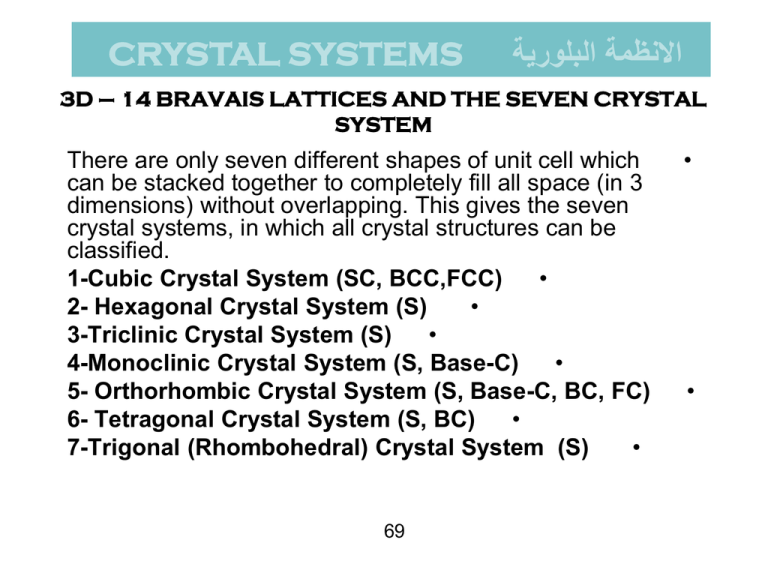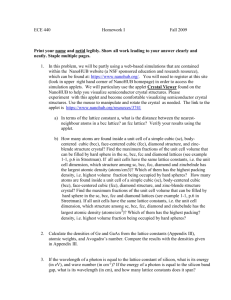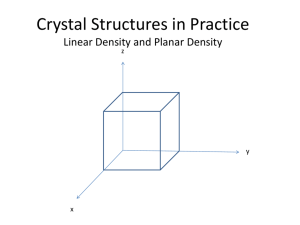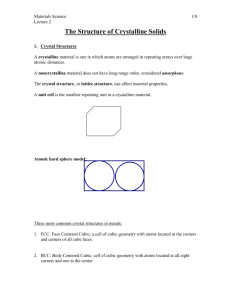ةيرولبلا ةمظنلاا CRYSTAL SYSTEMS
advertisement

CRYSTAL SYSTEMS االنظمة البلورية 3D – 14 BRAVAIS LATTICES AND THE SEVEN CRYSTAL SYSTEM There are only seven different shapes of unit cell which can be stacked together to completely fill all space (in 3 dimensions) without overlapping. This gives the seven crystal systems, in which all crystal structures can be classified. 1-Cubic Crystal System (SC, BCC,FCC) • 2- Hexagonal Crystal System (S) • 3-Triclinic Crystal System (S) • 4-Monoclinic Crystal System (S, Base-C) • 5- Orthorhombic Crystal System (S, Base-C, BC, FC) 6- Tetragonal Crystal System (S, BC) • 7-Trigonal (Rhombohedral) Crystal System (S) • 69 • • االنظمة البلورية السبعة وشبيكاتها االربعة عشر 2 Crystal Structure 70 Coordination Number - Coordinatıon Number (CN) : The Bravais lattice points closest to a given point are the nearest neighbours. • - Because the Bravais lattice is periodic, all points have the same number of nearest neighbours or coordination number. It is a property of the lattice. • - A simple cubic has coordination number 6; a bodycentered cubic lattice, 8; and a face-centered cubic lattice,12. 71 • Atomic Packing Factor Atomic Packing Factor (APF) is defined as the volume of atoms within the unit cell divided by the volume of the unit cell. F.F= 72 • 1-CUBIC CRYSTAL SYSTEM نظام المكعب a- Simple Cubic (SC) Simple Cubic has one lattice point so its primitive cell. In the unit cell on the left, the atoms at the corners are cut because only a portion (in this case 1/8) belongs to that cell. The rest of the atom belongs to neighboring cells. Coordinatination number of simple cubic is 6. b c a 73 a- Simple Cubic (SC) 74 Atomic Packing Factor of SC 75 b-Body Centered Cubic (BCC) BCC has two lattice points so BCC is a non-primitive cell. BCC has eight nearest neighbors. Each atom is in contact with its neighbors only along the bodydiagonal directions. Many metals (Fe,Li,Na..etc), including the alkalis and several transition elements choose the BCC structure. 76 b c a Atomic Packing Factor of BCC 4R a= 3 APF BCC = 2 77 V atoms = 0.68 V unit cell (0,433a) c- Face Centered Cubic (FCC) - There are atoms at the corners of the unit cell and at the • centre of each face. -Face centered cubic has 4 atoms so its non primitive cell. • -Many of common metals (Cu,Ni,Pb..etc) crystallize in FCC • structure. 78 3 - Face Centered Cubıc Crystal Structure 79 Atoms are all same.11 Atomic Packing Factor of FCC 4R a= 3 V atoms 0,74 = 0.68 APF BCC FCC = V unit cell 4 80 (0,353a) Unit cell contents Counting the number of atoms within the unit cell Atoms corner face centre body centre edge centre lattice type P I F C Shared Between: 8 cells 2 cells 1 cell 2 cells Each atom counts: 1/8 1/2 1 1/2 cell contents 1 [=8 x 1/8] 2 [=(8 x 1/8) + (1 x 1)] 4 [=(8 x 1/8) + (6 x 1/2)] 2 [=(8 x 1/8) + (2 x 1/2)] 81 Example: Atomic Packing Factor 82 2 - HEXAGONAL SYSTEM A crystal system in which three equal coplanar axes intersect at an angle of 60 , and a perpendicular to the others, is of a different length. 83 2 - HEXAGONAL SYSTEM 84 Crystal Structure 85 17 3 - TRICLINIC and 4 - MONOCLINIC CRYSTAL SYSTEM Triclinic minerals are the least symmetrical. Their three axes are all different lengths and none of them are perpendicular to each other. These minerals are the most difficult to recognize. Triclinic (Simple) a ß g 90 oa b c Monoclinic (Simple) a = g = 90o, ß 90o a b c 86 • Monoclinic (Base Centered) a = g = 90o, ß 90o a b c, 5 - ORTHORHOMBIC SYSTEM Orthorhombic (Simple) a = ß = g = 90o abc Orthorhombic (Basecentred) a = ß = g = 90o abc Orthorhombic (BC) a = ß = g = 90o abc 87 Orthorhombic (FC) a = ß = g = 90o abc 6 – TETRAGONAL SYSTEM Tetragonal (BC) a = ß = g = 90o a=bc Tetragonal (P) a = ß = g = 90o a=bc 88 7 - Rhombohedral (R) or Trigonal Rhombohedral (R) or Trigonal (S) a = b = c, a = ß = g 90o 89





